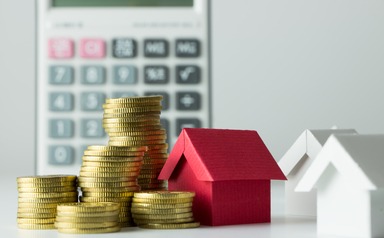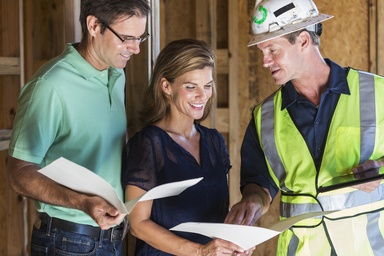There are several ways to build home equity, most of which are not under your control. Simply put, home equity is simply the difference between your property's value and the mortgage balance(s) against it. There are several ways to accumulate home equity or accelerate the rate at which you build equity in your home. All involve either increasing the value of your home or decreasing the amount you still owe on it.
Most homeowners start with an equity stake when they purchase their home; it's called the downpayment. From the mortgage lender's side, this is expressed as a Loan-To-Value (LTV) ratio. If you make a 5% down payment, you have a 5% equity stake in the property, and the amount of the loan against it is 95% of the value of the home (95% LTV ratio).
How does your home equity stake increase?
- You make monthly mortgage payments over many years;
- You make extra payments to reduce the outstanding principal whenever possible;
- Home values are increasing in your area;
- You refinance to a mortgage with a shorter term;
- You make improvements to your home to increase its value.
Mortgage Amortization: How Making Payments Works
The first thing you'll notice when you calculate a mortgage amortization schedule for your loan is that almost none of the payment initially goes toward reducing your principal balance -- it's nearly all interest. Although it increases over time, only about two percent of your principal balance is paid off after the first year of a 3.5% 30-year fixed rate loan.
Mortgage interest is calculated as a percentage of the remaining balance on your mortgage, so early in the process, only the small amount left over after the interest is paid gets credited toward reducing your principal. Over time, as your balance decreases, the amount allocated to reducing your loan balance increases until nearly all of your monthly payment goes toward retiring your loan.
Related: When will I begin paying more principal than interest on my mortgage?
Mortgage Prepayment Strategies
There are many strategies for increasing the rate at which you accumulate home equity. All of them involve paying more to reduce your principal balance faster.
Among the most common methods of mortgage prepayment are simply Rounding up Your Mortgage Payment to the next $5, $10 or $25 increment. Another is simply sending in a fixed extra amount of money each month. There are other methods, too, such as refinance-and-prepay scenarios, lump-sum prepayments and others.
When you prepay to build home equity, starting early in the loan has the greatest effect. Consider a $100 per month prepayment for ten years on a $200,000 30-year fixed-rate mortgage at 3.5%. In one scenario, you start at the very first payment; in the other you start prepaying after five 5 years. Comparing results at the halfway point of your mortgage (after payment 180), starting prepayment early means your remaining loan balance is about $2,600 less than if you started after the 60th payment. It's the same total amount of prepayment ($100 x 120 months = $12,000) but the cumulative effect on building equity is greater when you start early.
Related: HSH's Comprehensive Guide to Prepaying Your Mortgage
Your Neighborhood and Home Values
Many studies show that real estate values have historically increased at a rate similar to inflation -- according to the FDIC, home values have increased at an annual rate of about 5%. Unless you're in a booming or busting area, that sort of increase is fairly typical over time. However, it's important to consider that this number changes over time -- in any given period, there can be decreases in value, stretches of only small gains or periods where prices are leaping. The problem is, you can't know in advance what to expect, so counting on the housing market to create equity for you may not be a reliable means.
See HSH's Home Value Tracker:sm What's happening with home values in your area
Knowing how much equity you have will generally require an appraisal, but your approximate equity stake today can be reckoned and future equity stakes projected by using HSH's unique KnowEquitysm Tracker and Projector calculator. With it, you can learn where you are in your mortgage today, get a working sense of what's happened to the value of your home over your ownership period, and used median value changes in your market to see when you'll have a given equity stake in the future.
For example, if you bought a $250,000 home with a 20% down payment in the Charlotte metro area in October 2016, based on what's happened to home values in that market, your home would now be worth $393,644; your remaining loan balance would be $179.394 so your equity stake (including your original down payment) would be $214,250. If you want to know when you'll have a $300,000 equity stake, the calculator will utilize median home value appreciation in the market and take into account your payments and return the date when that's likely to occur (in this case, after you've made another 55 payments).
How Mortgage Refinancing Affects Your Equity Position
Refinancing can help you build home equity -- or it can see you use it up. Since refinancing costs can often be rolled into the new mortgage, you might not realize their impact. For example, if that $200,000 home loan has a 4.5% interest rate, and the lowest mortgage rate you can get is now 3%, refinancing is not a no-brainer.
If you have been paying your home loan for five years at 4.5% (you still owe $182,316) and can get a 3% interest rate which costs you two points (2% of the loan balance, some $3,646), plus $3,000 in closing costs, you take a big equity step backward. Use HSH.com's refinance calculator and you'll see why: Although your payment will drop to from $1,013 to $797 due to a lower rate and restarting a 30-year term, your loan balance increases by $6,646, so your new loan at 3% starts with a balance of $188,962. In this case, you've improved your cash-flow position, but refinancing has eaten up years of equity building, reset your amortization clock back to the beginning and added another five years of payments before your home is paid off. It's hard to build equity more quickly with these headwinds.
What if you can shorten the term? Since interest rates on shorter-term mortgages are lower than on longer-term ones, getting a 3% interest rate on a new 15-year loan would cost less in fees. However, cutting 10 years off your existing mortgage likely means that your monthly payment will increase; in this case, and including likely fees of no points but $3,000 in closing costs (loan balance being refinanced of $185,316), in this case to $1,280, about $267 per month more than you're currently paying. However, this "forced" prepayment means that you'd be done ten years earlier than if you hadn't refinanced, and you'll save over $76,000 in interest cost... and you'll have 100% ownership (that is, 100% equity in our home) some ten years sooner than if you didn't make the change.
Can't make the leap in payment to a 15-year term? A 20-year term at 3.5% (cutting 5 years off your original loan and saving over $49K in interest cost) would increase the monthly payment by just $62 per month. Of course, you can always refinance to a new 30-year term and then make your mortgage any term you want.
Improving Your Home to Increase Home Equity
Very few major improvements offer a return greater than the cost to make them. That is, you generally won't get back all of the money you invest in a home improvement project.
That's OK; most folks that undertake remodeling projects do so with the intent to make their home more livable for themselves, and aren't specifically concerned with increasing their equity position at the outset (and often use equity in the home to finance the improvements, too). That said, permanent improvements (adding bedrooms, bathrooms, etc.) will tend to increase in value relative to their cost over time (along with the dwelling) but the return on renovating existing spaces like bathrooms and kitchens may not hold up long term as wear and tear take their toll.
According to many real estate experts, generally, renovations that pay off the most are changes that correct defects that make your home less desirable and/or valuable relative to others in your neighborhood. For example, if everyone else on your block has three bathrooms and you only have one, you may need to do some updating.
The good news, though, is that many improvements that offer the greatest return on your investment can also be the cheapest, although to realize their value, you'll either need to be looking to take out a home equity loan or line or credit or selling your home outright. Relatively low-cost, high-ROI items include things like:
- Deep cleaning and decluttering. Expand your storage options or get rid of things for which you have no room. A professional cleaning can make your home stand out when competing for buyers.
- Updating lighting fixtures and access. Replace broken lights and burned out bulbs. Change out dated or dirty attached fixtures both inside and outside. Clean windows and skylights to let more light in.
- Improve curb appeal. Store anything that doesn't improve the drive-by look of your home -- equipment, cars, trash cans, etc. Have a gardener or landscaper trim bushes and plants, get your lawn or hardscaping in shape, add flowers, trees, or plants.
- Plumbing and electrical. More pricey, but it's a good idea to repair or replace defective plumbing or outdated electrical outlets and panels. If you're selling, you'll may need to, anyway.
- Kitchen and bath freshening. These don't have to be huge projects; repainting goes a long way, as does resurfacing cabinets. Replace anything dingy, dated or worn: toilet seats, faucets, drawer or cabinet handles. Clean, caulk, and redo grout in sinks, tubs, showers, and on countertops.
- Interior paint. Repair and patch damaged interior walls, then touch up or repaint them in a neutral color.
- Clean or replace carpets. Professional cleaning may suffice if they're not heavily worn or soiled. Otherwise, replace them.
- Clean or refinish flooring. Refinish or repair damaged or worn wood floors, or cover with carpets; clean/regrout and reseal tile floors, and replace worn vinyl with new.
- Exterior paint. Entryways get the first look from potential buyers, so start there. Moving on, repaint exterior surfaces for instant brightening - or even the whole house, if the paint's not in particularly good shape.
- Roof and gutters. If there are tress growing out of your gutters or the moss on the roof is thicker than your lawn, consider having both cleaned. There are lots of pros or handymen who specialize in these kinds of projects and it can be worth a few hundred dollars to have them tackled.
There are many ways to build home equity. Take charge of what you can control for a better financial future.
Related: HSH's Comprehensive Guide to Home Equity Loans and Lines of Credit



